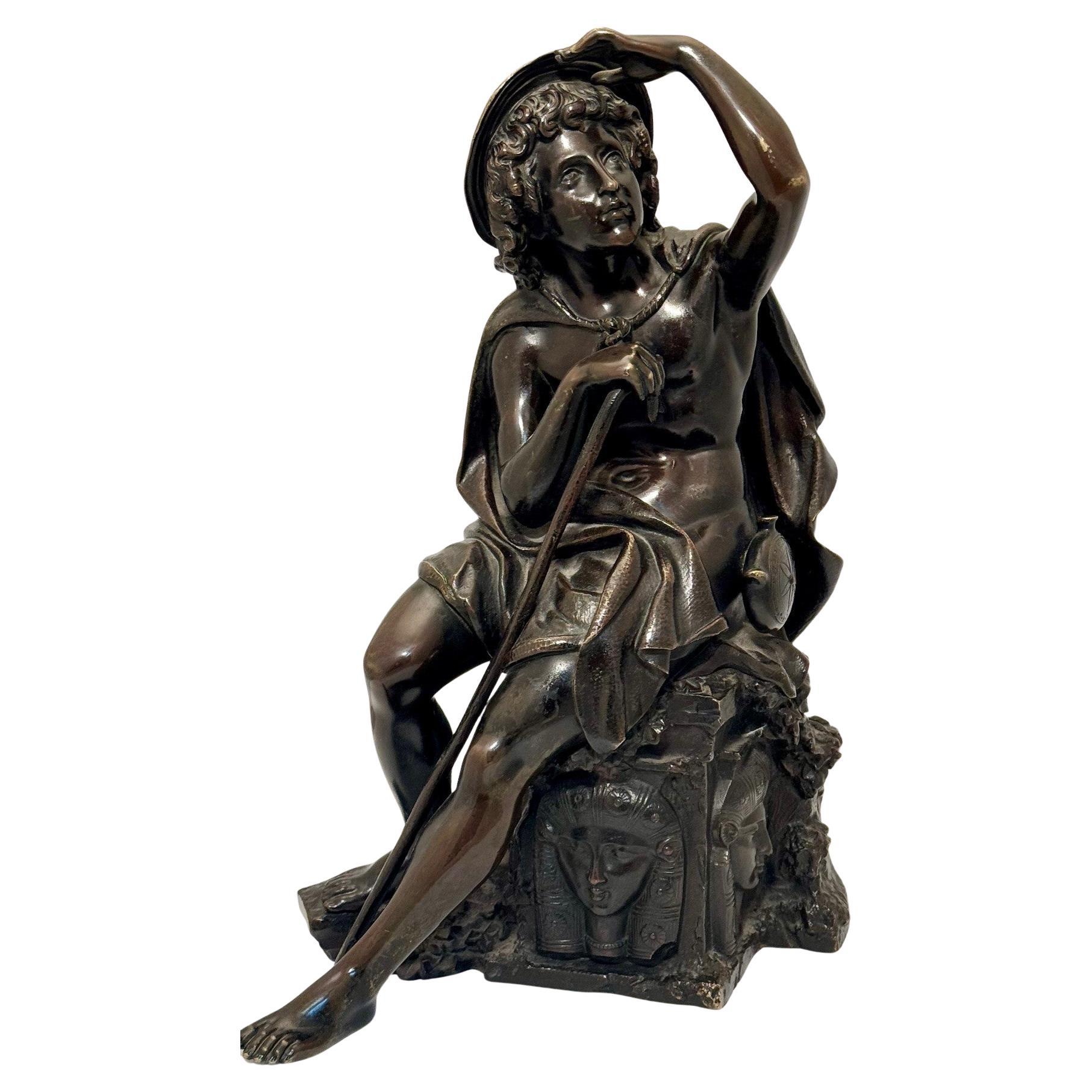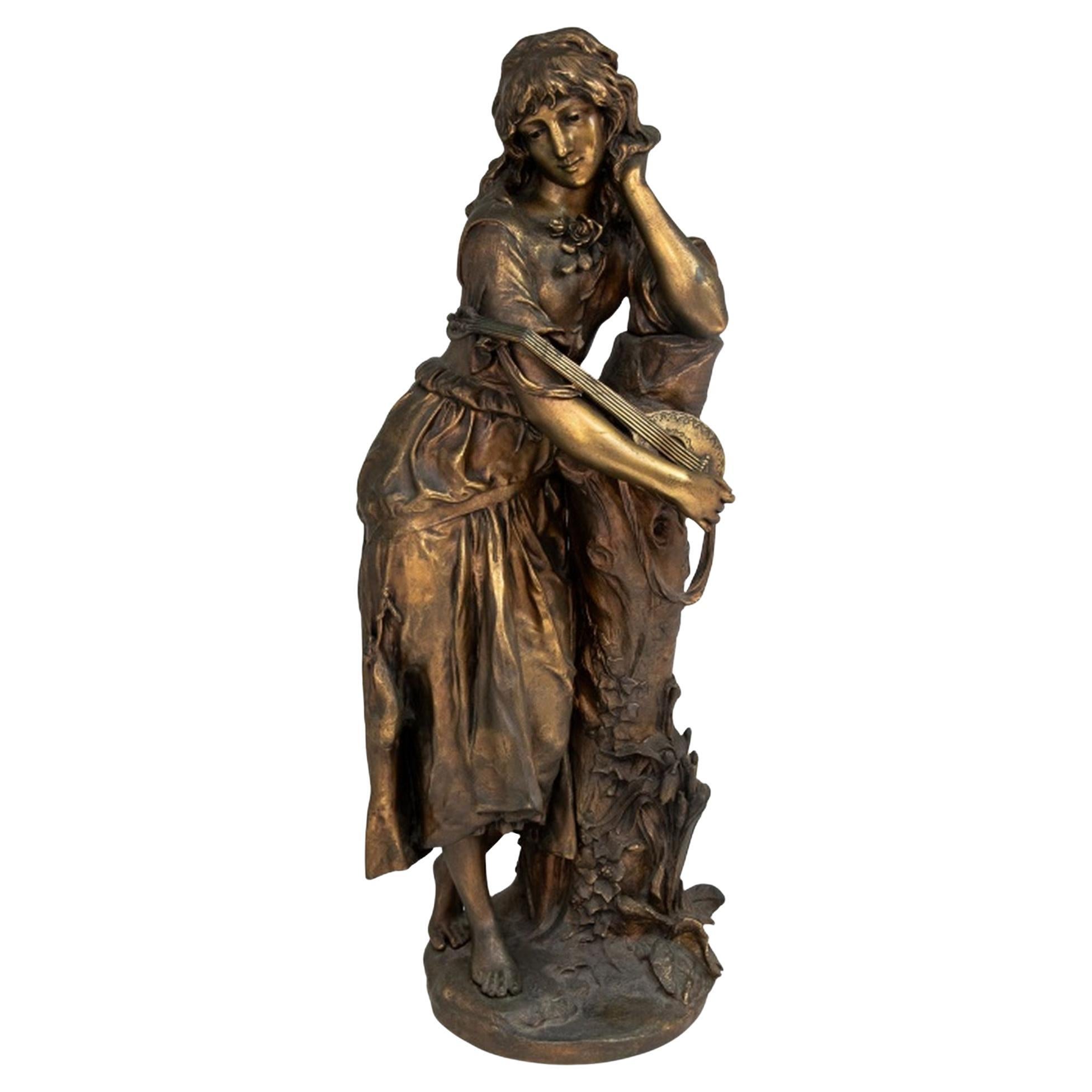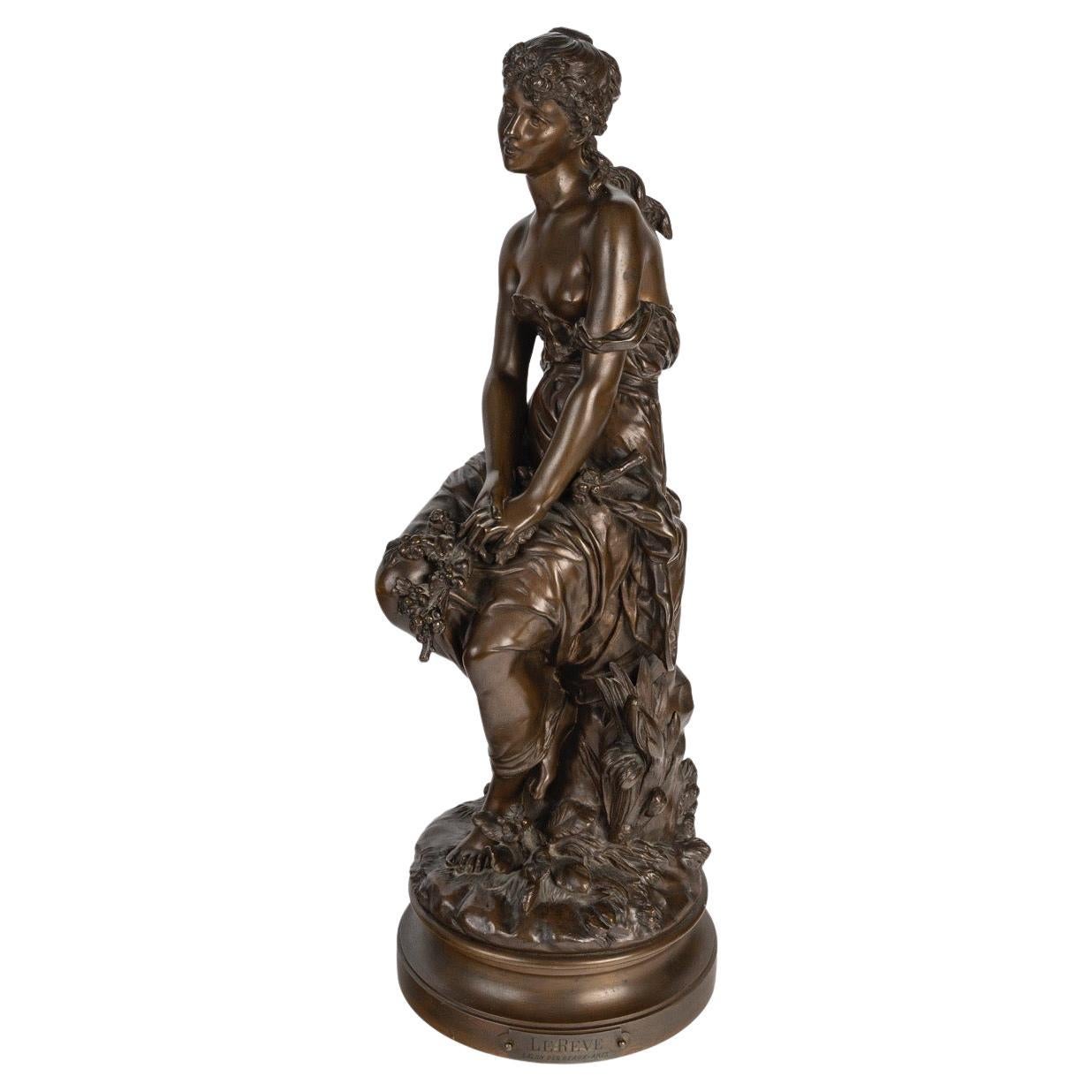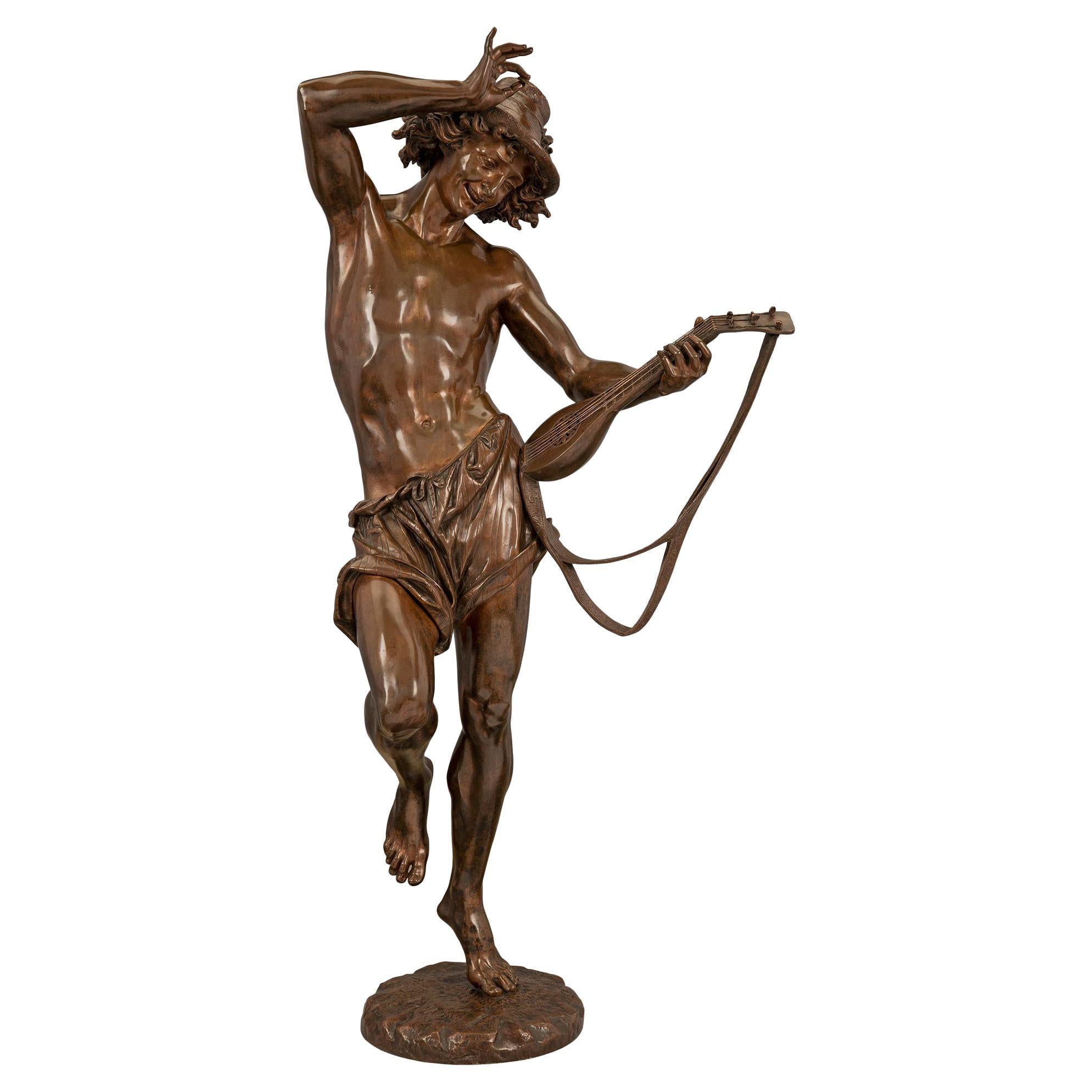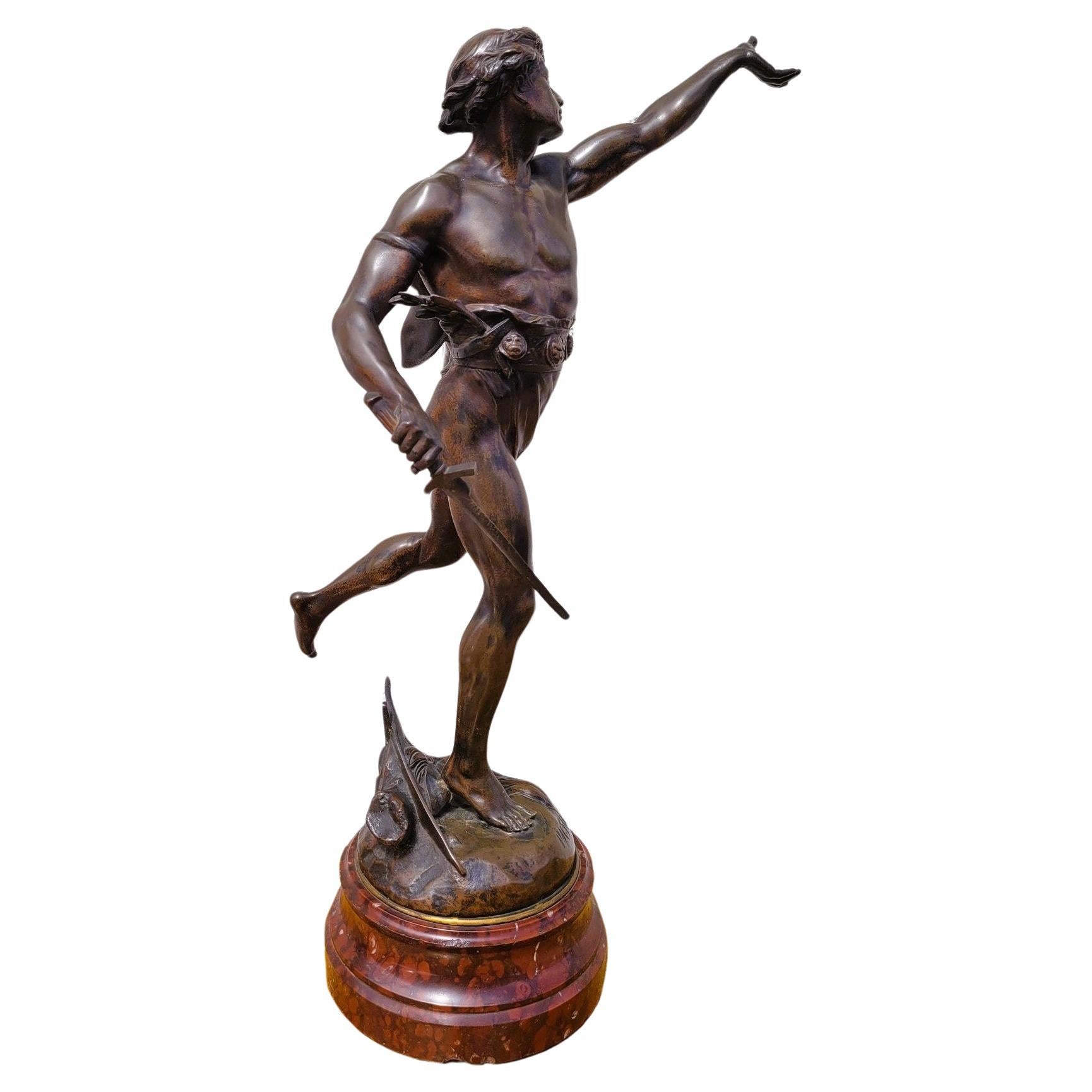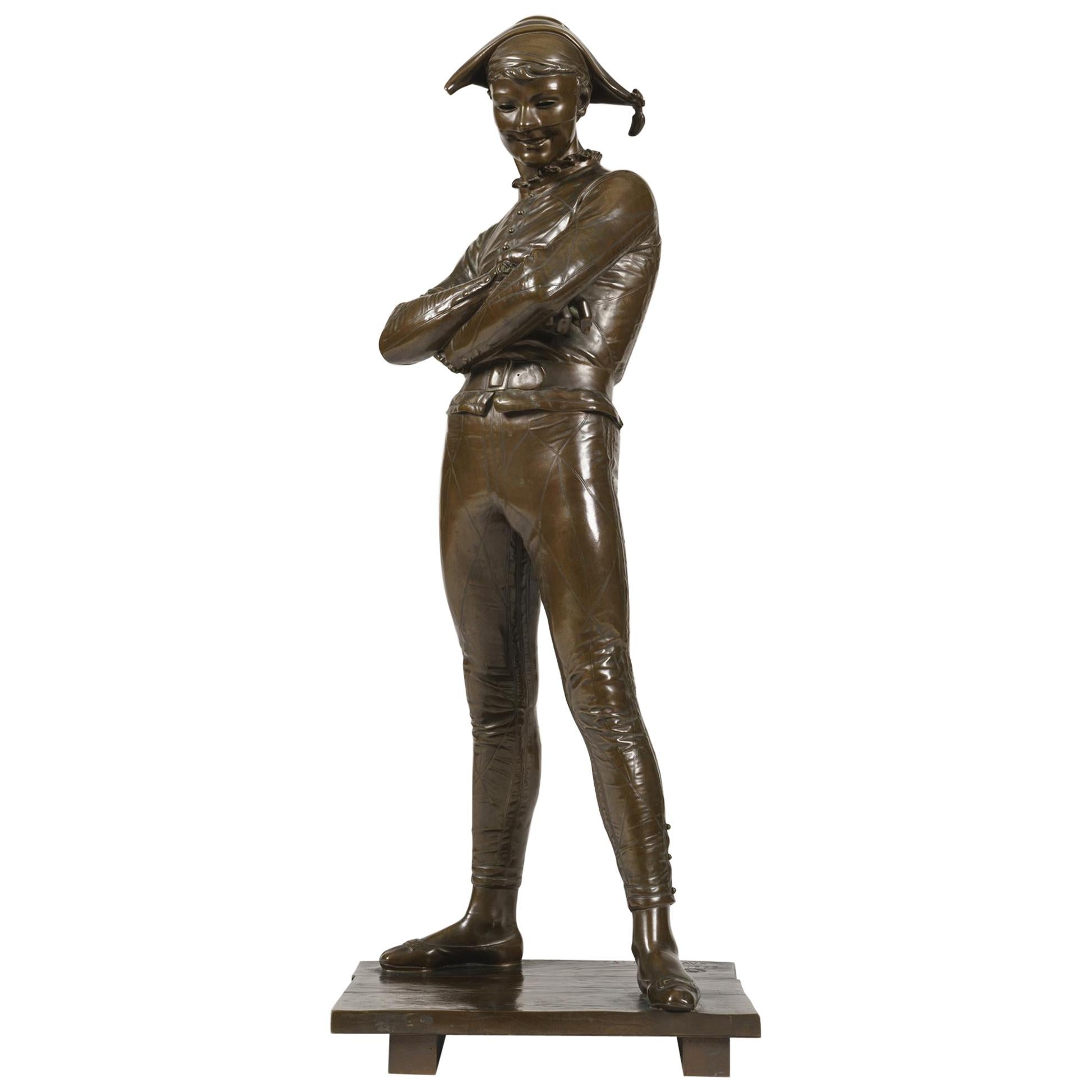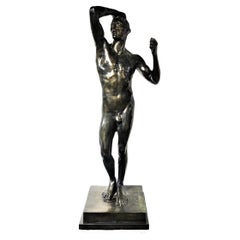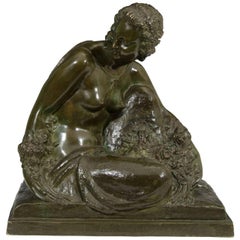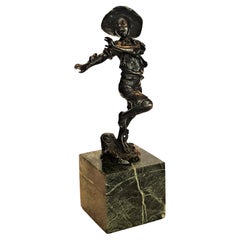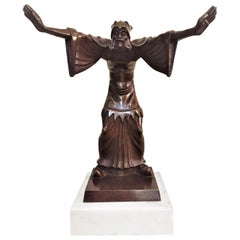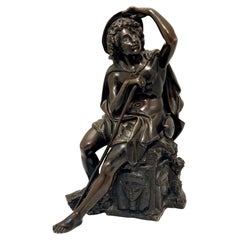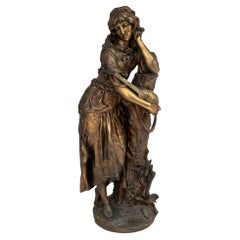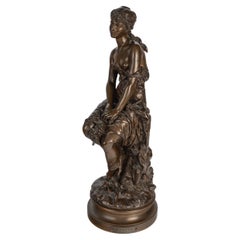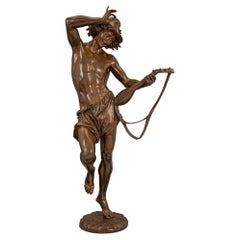Items Similar to Émile Hébert, the Wanderer, Belle Époque Patinated Bronze Sculpture, circa 1880s
Want more images or videos?
Request additional images or videos from the seller
1 of 13
Émile Hébert, the Wanderer, Belle Époque Patinated Bronze Sculpture, circa 1880s
$7,800
£5,886.45
€6,739.09
CA$11,000.59
A$12,077.27
CHF 6,300.74
MX$146,151.80
NOK 78,969.98
SEK 74,410.48
DKK 50,305.51
About the Item
Émile Hébert, the wanderer, French Belle Époque patinated bronze sculpture, circa 1880s
Dimensions:
Height 24.75”
Width 10.5”
Depth 5.75”
Pierre-Eugène-Émile Hébert (French, 1823–1893) A native Parisian, Hébert apparently lived and worked in the capital until his death. He was born in 1828, and studied sculpture privately, with his father Pierre (1804-1869) and Jean-Jacques Feuchère (1807-1852), both of whom pursued modestly successful careers in the Salon and as public sculptors beginning in the 1830s. Hébert learned extensively from their very divergent paths. Whereas Pierre Hébert, a laborer's son, trained at the Ecole des Beaux-Arts, Feuchère emerged within the art-bronze industry of his family, where he also prospered, providing various founders with models throughout his career. The latter was, in fact, one of the most masterful practitioners of the romantic anti-classical historical idiom, and particularly of the neo-medieval macabre; Feuchère is best known today for his sinuous figure of Satan, a serial bronze in various sizes. Emile Hébert is the able successor to both sculptors in all such categories.
Hébert began his Salon career during the Second Republic, with portrait busts of eminent sixteenth-century figures that were immediately purchased by the government. He then exhibited statuettes representing a variety of subjects--genre, classical mythologies, and the satanic. Well respected in official circles by the mid-1850s, Hébert was chosen, along with his father, to represent France in the Fine-Arts section of the 1855 Paris Universal Exposition. The state commissioned or acquired several of Hébert's works: a Bacchus for the Tuileries Palace (1866, present location unknown); personifications for the facade of the théâtre du Vaudeville, Paris; The Oracle, a marble relief (vestibule, Musée de Vienne, Isère); portrait-statues of great French writers of the sixteenth and seventeenth centuries such as Jean-François Regnard (1880, facade, Hôtel de Ville, Paris) and François Rabelais (erected 1882, Quai Jeanne d'Arc, Chinon).
Anne Pingeot discovered hitherto-unknown allegories by Hébert of anatomy and Etruscan art on the facade of the Nouveau Louvre (Pavillon Sully and between the Pavillons Daru and Denon, respectively, the latter signed and dated 1856). The sculptor showed regularly in the Salon until his death in 1893. Though he appears not to have had strong critical impact in Third-Republic exhibitions, the government of that time repeatedly chose Hébert's work to represent the nation internationally; his state-owned works appeared in the French Fine-Arts section of the 1873 Vienna Universal Exposition.
Thanks to Catherine Chevillot's unpublished research on nineteenth-century French foundries, it emerges that Hébert's lifetime reputation instead rests heavily upon his prolific work for the art-bronze industry throughout his career. Unlike most entrepreneurial animaliers and Carpeaux, who cast and marketed their own works, Hébert produced models for edition in bronze, plaster, and terracotta by other founders for at least thirty years. Though they frequently obtained reproduction rights, founders commonly identified Hébert as the sculptor in the catalogue and on the casts. He is recorded as providing models for a founder known only as E. Vittoz (a bronze Mephistopheles, for example); for another known only as E. Sévenier (a clock ornament of Hide-and-Seek, in addition to busts and groups); and for Auguste Gouge (Oedipus and the Sphinx, in bronze and plaster variants). Hébert's best-recorded and apparently longest-lived relationship, however, was with a founder today known only as G. Servant, whom the sculptor supplied with new models and variants of his Salon entries from the 1860s until Servant sold the business in 1882. Hébert's serial designs were thus seen and reviewed, possibly triggering orders at the founders' displays at the international exhibitions in London and on the continent through at least the 1870s. Nonetheless the studio sale after his death in 1893 reveals he retained reproduction rights and molds to many models, including his celebrated group Et Toujours!! Et Jamais!!
Known in various materials and sizes, Et Toujours!! Et Jamais!! remains Hébert's best-known work today. The plaster, shown in the Salon of 1859 (present location unknown), and the bronze, shown in the Salon of 1863 (possibly the 150-centimeter cast at the Spencer Museum of Art, University of Kansas, Lawrence), riveted the critics of the time, including Charles Baudelaire. Its poetically enigmatic title, darkly erotic "Death and the Maiden" treatment, Hugo-esque play on beauty and the grotesque, fluid, sinuous forms, and rippling textures reflect the mid-century romantic resurgence.
Hébert, however, commanded a variety of modes. He was a superb modeler of the human form and of ornament, and manipulated both with great complexity, whether in monumental format or in small scale. Hébert's serial work especially reveals his modeling skill. His art bronzes range in subject from ancient mythologies--classical, Egyptian, and Mesopotamian--to contemporary athletes: boxers, rowers, champions. The sports figures often display the florid neo-baroque realism of his architectural decoration; so too the humorous moral allegories such as Ecole de filles [Girls' School]. Hébert often adjusted his style to historical subject: severe neo-Greek handling in his Thetis, Oracle, and Oedipus and the Sphinx; and stylized and rigid neo-Egyptian handling in his busts of Rameses and Isis. Some of his most intriguing work is in this historicizing mode, which provides especially useful insights into nineteenth-century French orientalism. Models in this vein for the founder Servant often reflect the eclecticism of better-known orientalist works by other artists in sculpture, painting, and theater that display an arresting mix of styles and ornament.
However, Hébert also produced compositions that are tantalizingly advertised in sales catalogues as "restitutions" of known museum pieces: two sizes of the so-called Trophonius bust from the "Musée Assyrien" (the newly formed Assyrian collection at the Louvre), for example. Though unknown today, such a model could be a freely interpretative caprice on a known fragment or an earnest reconstruction.
Hébert's frequently poetic approach to his Salon works, sophisticated historicism of his serial work, and evident familiarity with museum collections suggest he was deeply engaged in the contemporary world of learning.
- Creator:Pierre-Eugène-Émile Hébert (Sculptor)
- Dimensions:Height: 24.75 in (62.87 cm)Width: 10.5 in (26.67 cm)Depth: 5.75 in (14.61 cm)
- Style:Belle Époque (Of the Period)
- Materials and Techniques:Bronze,Patinated
- Place of Origin:
- Period:
- Date of Manufacture:1880s
- Condition:Wear consistent with age and use. We make our best effort to provide a fair and descriptive condition report. Please examine the photos attentively. Send us a message to request more details or discuss price.
- Seller Location:New York, NY
- Reference Number:1stDibs: LU2819315847721
About the Seller
5.0
Gold Seller
Premium sellers maintaining a 4.3+ rating and 24-hour response times
Established in 1993
1stDibs seller since 2017
86 sales on 1stDibs
Typical response time: 8 hours
- ShippingRetrieving quote...Shipping from: New York, NY
- Return Policy
Authenticity Guarantee
In the unlikely event there’s an issue with an item’s authenticity, contact us within 1 year for a full refund. DetailsMoney-Back Guarantee
If your item is not as described, is damaged in transit, or does not arrive, contact us within 7 days for a full refund. Details24-Hour Cancellation
You have a 24-hour grace period in which to reconsider your purchase, with no questions asked.Vetted Professional Sellers
Our world-class sellers must adhere to strict standards for service and quality, maintaining the integrity of our listings.Price-Match Guarantee
If you find that a seller listed the same item for a lower price elsewhere, we’ll match it.Trusted Global Delivery
Our best-in-class carrier network provides specialized shipping options worldwide, including custom delivery.More From This Seller
View AllAuguste Rodin, Age of Bronze, Male Nude Patinated Bronze Statue Re-Cast, XX C.
By Auguste Rodin
Located in New York, NY
Auguste Rodin
Age of Bronze
Patinated Bronze Sculpture Re-Cast
XX Century
ABOUT THE ARTWORK
Rodin's breakout sculpture, The Age of Bronze (L'Age d'airain) caused a critical scandal ...
Category
20th Century French Belle Époque Figurative Sculptures
Materials
Bronze
Marcel-André Bouraine, Nude, French Art Deco Bronze Sculpture, circa 1920s
By Marcel-André Bouraine
Located in New York, NY
An Art Deco bronze sculpture of a seated semi-nude woman by Marcel-André Bouraine, French, 1886-1948.
Category
Vintage 1920s French Art Deco Figurative Sculptures
Materials
Bronze
$4,550 Sale Price
30% Off
Carl Kauba, Frightened by the Frog, Viennese Bronze Sculpture, circa 1915
By Carl Kauba
Located in New York, NY
Dimensions
Total Height: 7.5 inches
Base Height: 2 inches
Width: 2.75 inches
Depth: 2.75 inches
ABOUT
This charming desk figurine in dark brown patinated Viennese bronze by the famous Austrian sculptor Karl Kaub stands out for the originality and humor of its subject matter. The author depicted with amazing subtlety a boy who jumped on one leg in fright, suddenly seeing a frog sitting on his arm.
CARL KAUBA (Austrian, 1865-1922) was born August 13, 1865 in Vienna, Austria. The son of a shoemaker, Kauba chose to follow his calling into the world of art. Collectors now rank him in a class with Remington and Russell as one of the great portrayers of American Western. His subjects were typically American Indians, calvarymen, cowboys, and roughriders. In addition to his American bronzes, Kauba produced a lifetime’s worth of Austrian statuary. His work became fully appreciated on both sides of the Atlantic.
Carl studied at the Academy of Fine Arts in Vienna under professor Laufenberg. Later he would study at the academies under Carl Waschmann and Stefan Schwartz. Next, he went to Paris in 1886 to further study before he set off for the U.S. In fact, some debate still remains as to whether Kauba ever visited the U.S.
Kauba’s fascination with the West was fired by the stories of the German writer, Carl May, whose tales of Western adventure were well known throughout Europe. Most authorities feel that he was about twenty-five years old when he traveled widely throughout the American West. He then returned to Austria with voluminous notes, sketches, and several models of Western sculpture...
Category
Vintage 1910s Austrian Jugendstil Figurative Sculptures
Materials
Bronze
Jenő Kerényi, Magician, Hungarian Art Deco Patinated Bronze Sculpture, 1930s
Located in New York, NY
Signed KEREMYI on the back of the plinth.
Some patina abrasions are noticeable in the back area.
The white Carrera marble base obviously is a later replacement.
Dimensions:
Height 14.75”
Width 11.75”
Depth 7.75”.
Jeno Kerényi...
Category
Vintage 1930s Hungarian Art Deco Figurative Sculptures
Materials
Bronze
Italian Art Deco, Equestrian Groom, Patinated Bronze Sculpture, 1920s
Located in New York, NY
Signed on the base: “DITA”.
Impressed foundry stamp.
Category
Vintage 1920s Italian Art Deco Figurative Sculptures
Materials
Bronze
Franz Xaver Bergmann, Odalisque, Vienna Bronze Sculpture, Ca. 1900
By Franz Xaver Bergman (Bergmann)
Located in New York, NY
This wonderful life-like sculpture depicts a half-naked odalisque reclining in a lazy pose on silk pillows on an ottoman, covered with a lion's skin. With bare breasts, only a small ...
Category
Antique 1890s Austrian Art Nouveau Figurative Sculptures
Materials
Bronze
You May Also Like
Theo. Coinchon 1814-1881 "Traveler" Antique Bronze
By Jacques Antoine Theodore Coinchon
Located in Montreal, QC
This Bronze is very attractive, featuring a traveling youth looking into the distance, He has a sun-hat staff and water canteen and sits on a rocky outcr...
Category
Antique Late 19th Century French Belle Époque Figurative Sculptures
Materials
Bronze
Adrien Gaudez "Mignon" Patinated Bronze Sculpture
By Adrien Étienne Gaudez
Located in Astoria, NY
Adrien Etienne Gaudez (French 1845-1902) "Mignon", Patinated Bronze Sculpture, late 19th century, the standing female resting against a tree stump and holding a lute, on a circular b...
Category
Antique Late 19th Century French Belle Époque Figurative Sculptures
Materials
Bronze
"Le. Rêve"- Hippolyte François Moreau (1832-1927) Figurative Bronze Sculpture
By Hippolyte François Moreau
Located in Saint-Ouen, FR
"The Dream" - Hippolyte François Moreau (1832-1927)
Figurative bronze sculpture
"The Dream", Figurative bronze sculpture with brown patina
On a rotating base bearing a cartouche en...
Category
Antique 1880s French Belle Époque Figurative Sculptures
Materials
Bronze
French 19th Century Belle Époque Period Patinated Bronze Statue
Located in West Palm Beach, FL
A stunning and high quality French 19th century Belle Époque period patinated bronze statue of a man dancing and playing a mandolin. The statue is raised by a circular base with a te...
Category
Antique 19th Century French Belle Époque Figurative Sculptures
Materials
Bronze
E Picault, Victoria, Bronze Sculpture, Late 19th Century
By Émile Louis Picault
Located in MARSEILLE, FR
Victoria: bronze sculpture with a brown patina of a victorious warrior, on a red marble base
This bronze is entitled "Victoria" and is signed by the artist Emile Picault
Emile Pica...
Category
Antique 19th Century French Napoleon III Figurative Sculptures
Materials
Marble, Bronze
Antique Bronze Statue of Arlequin by René de Saint-Marceaux
By Ferdinand Barbedienne
Located in London, GB
A bronze Statuette of Arlequin
by Charles-René de Paul de Saint-Marceaux
Cast by Barbedienne. The mischievous Harlequin, arms crossed in contemplation, wearing a grin and a mask, tr...
Category
Antique 1880s French Belle Époque Figurative Sculptures
Materials
Bronze
